#yes all of them
Text
“people become ghosts in bbc ghost when they have unfinished business” wrong! you become a ghost if you have autism
962 notes
·
View notes
Text
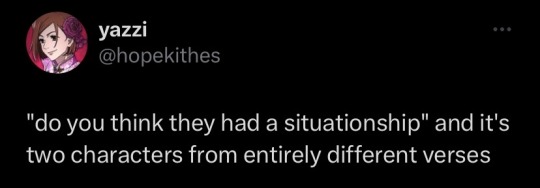


do you think they had a situationship
#yes all of them#doctor who#the doctor#fifteenth doctor#not tagging all the doctors tho i’m too lazy#harry houdini
347 notes
·
View notes
Text
flight rising is down bc they're making all the dragons transgender in honor of tdov

634 notes
·
View notes
Text
Flat Stanley

#Velvety Free-tailed bat#Bats of the Americas#Yes all of them#North South And Central#Bat of the day#daily bat#bat#bats#batposting#cute bats#cute animals#Flat bat#Flat stanley#lil buddy#small sky pupper
225 notes
·
View notes
Text
UnderVerse redraws with Papyruses bc I want to and he deserves to be badass tho



Error/FreshTale (and Error!Papyrus) belong to @loverofpiggies
XTale (Papyrus) belongs to @jakei95
____Tale belongs to myebi (dude my adhd sucks I done forgor 💀)
FreshTale and InkTale Papyrus’ designs belong to @insanelyadd
#paypurr art#art#artists on tumblr#undertale#papyrus#papyrus undertale#undertale au#utmv fanart#utmv#undertale multiverse#xtale papyrus#i call him mark lol#error papyrus#ink papyrus#fresh papyrus#underverse#screenshot redraw#underverse redraw#comfort char#yes all of them#hashtag let papyrus be sinister
481 notes
·
View notes
Text
Elle x Emmett being the most perfect couple for over 25 mins - Legally Blonde the Musical
youtube
aka a compilation of all the moments in their relationship
#yes all of them#even the little background stuff#I noticed so many little things I never noticed before#lbb and cb just had a lot of fun together huh#my favorite background moment: them holding hands during the scene of the crime#can’t believe no one has made this video before#elle x emmett#elle woods#emmett forrest#legally blonde the musical#legally blonde#legally blonde musical#legally blonde broadway#laura bell bundy#christian borle#legally blonde video#edits in the palace#videos in the palace#first video of 2024!#Youtube
56 notes
·
View notes
Text
amazing how many of the dsmp character's story arcs can be boiled down to:
"I have to keep my friends safe by any means necessary!"
engages in self destructive behaviour
#c!dream#c!benchtrio#yes all of them#c!karl#c!quackity#oh I love parallels#I love all their stories and how they're each their own little hero in their own little fucked up world#dsmp#dream smp#dsmp lore#dreblr#c!awesamdude#(used the wrong tag again lol)
84 notes
·
View notes
Text
Why Peter Parker Was Not 15 When He Was Bit: A Treatise
This was originally a twitter thread but in an effort to save the one thing I actually care about having posted there from whatever the fuck is going on, here we go!
While early on there aren't any outright 100% indisputable references to Peter's age (i.e. himself or Aunt May just saying it outright on the page), from the very beginning of publishing, there have been enough references that give a firm grounding to Peter being a senior in high school throughout the first 28 issues of Amazing Spider-Man.
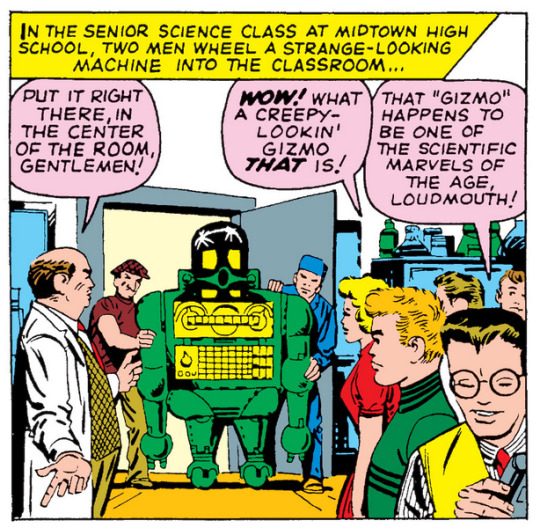
ASM 8 (Jan 1964)
Right off the bat in Amazing Spider-Man 8 (a tribute to teenagers xoxo you will always be famous) we get our first definitive mention that Peter and his classmates are in their senior year of high-school at the very least from this point on in the narrative.

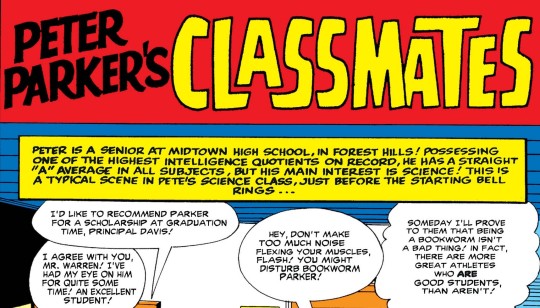
ASM 14 (Jul 1964); ASM Annual 1 (Oct 1964)
Peter himself states this 6 issues later trying to wheedle Aunt May into letting him go to Hollywood on assignment from JJJ to cover Spider-Man's cinematic debut in a film role offered to him by the Green Goblin (in his first comic appearance. When I say I love the Silver Age.) ASM Annual 1 confirms that the gang is in their senior year yet again.
This is already stupid long so the rest goes behind the cut!
This isn't something that's just dropped in the Silver Age and then forgotten. 26 years after those first mentions, Web of Spider-Man Annual 4 makes a call back to Amazing Spider-Man 3 and places that moment in Peter's senior year of high-school:


Left: WOS Annual 4 (Oct 1988); Right: ASM 3 (Jul 1963)
While on tour to promote the Bugle-produced book of his Spider-Man photography, WEBS, Peter states on a TV interview that a photo of his first encounter with Doc Ock was taken while he was a senior in high school.
"But Mabs," I hear you say, "so what if he's in his senior year in ASM! Even if that's true, that doesn't mean he was in his senior year in Amazing Fantasy 15, and that still doesn't establish an age! He's a super mega genius so like....he probably skipped grades, prodigy that he is! And there was a time gap btw AF15 and ASM1, right?"
Alright let's go through this. As mentioned earlier, yeah, references to Pete's age are very few and far between and are a bit wobbly but let's put them together. The first age ref we get is in ASM 16:
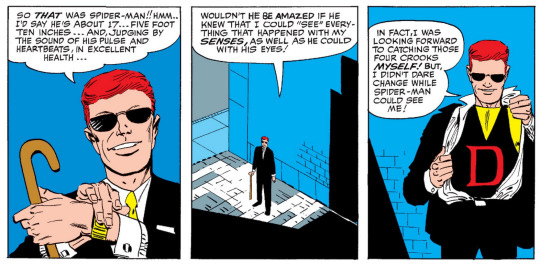
ASM 16 (Sep 1964)
Here our favorite public defender is "rescued" from a mugging by the webslinger. After Peter fucks off, Matt gives us the above rundown of Spidey's characteristics: about 17, 5'10" and in excellent health. So "about 17" which, granted, doesn't have to mean exactly 17 but since we've established that at this point Peter is def in senior year, based on NYS age matriculation dates, Matt's probably spot on.
New York State matriculates students based on the age they are on December 1st of a school year. A 1976 edition of school regulations lays out the process: "[a] child who attains the age of 5 by December 1 of the current school year must be admitted to the kindergarten if a district operates such a program". So this means that within the same kindergarten class, kids born from the beginning of the school year to November 30th would be turning 5, while kids born from December 1 through the end of the school year would turn 6 during the school year, and kids born over the summer would also turn 6 but wouldn't celebrate during the school year.
Following that, Sept through Nov babies would be 16-going-on-17 in the beginning of their senior year, Dec - June would be 17-going-on-18 during senior year, June - Aug would turn 18 after graduation.
Peter being 17 or 18 during the high-school run of ASM just makes sense and there's nothing in the writing up until this point to push against that! In fact, when you first start seeing the de-aging of Peter creep in, AF15 literally had to be changed to make a younger age fit!
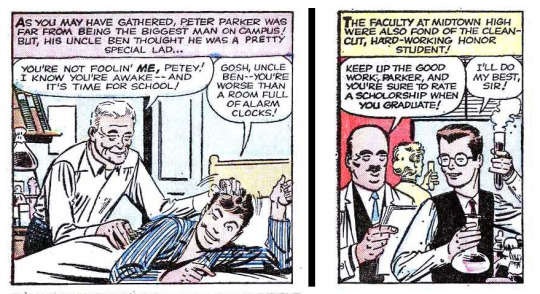
AF 15 (Aug 1962)
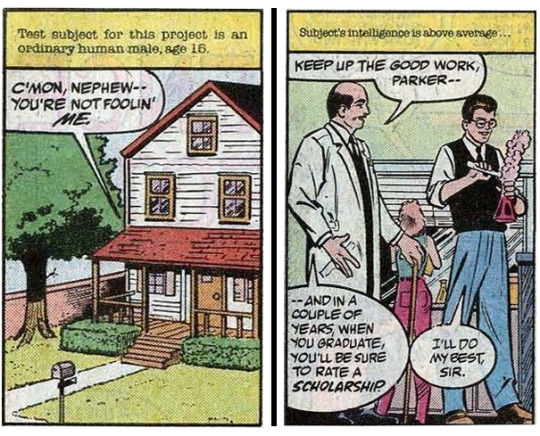
ASM Annual 23 (Sep 1989)
The very first time we see 15 floated as an age when Peter becomes Spider-Man is in the Amazing Spider-Man annual 23 of 1989. The annual is trying to present itself as Peter scientifically studying his own origin story, so the direct parallels to AF15 make it really clear when it's retconning the original to make sense with the younger age.
The panel where ASMAnn23 states Peter is 15 is otherwise a near word-for-word quote of AF15. Then later, the cognate panel of Peter in science class changes AF15's "you're sure to rate a scholarship when you graduate" to "in a couple of years when you graduate, you're sure to rate a scholarship." (Gerry Conway back at it again). This is the first time there's ever a hint at his story not being centered around his senior year, and that was made explicit in this issue by changing the original dialogue in order to justify stating he was a 15 year old in this recollection of AF15!
This is also an argument against the 'skipped grades' premise. Conway could have easily just left the text of AF15 as it was which would hint that Peter was obviously very young for being a senior in high school, but instead he tried to push AF15 back in time to fit a usual high-school timeline for a 15 year old (who would be at the earliest a December baby in their freshman year and the latest a Sept-Nov baby in sophomore year, and would be 'a couple of years' away from graduating).
Plus, fr if you're gonna argue that he skipped grades, it's on you to prove that. There are literally zero references to that throughout 616 continuity so like, why tf should it be taken as given? Please.
Anyway. And so are sown the seeds for torturing the already stretched timeline to make Peter an uwu baby infant. They didn't take right away. References to age go away after this and only resurface in 1994 (as far as I could see), where we see him aged back up:

ASM 395 (Nov 1994)
'I can't believe I was only sixteen when that spider bit me' actually makes sense with all of ASM being established as fully in Peter's senior year, Matt gauging him at 'about 17' in ASM 14, the age matriculation cut off for NYS schools, and the timeframe established between AF15 and ASM Annual 1 from 1964:

ASM Annual 1 (Oct 1964)
ASM Annual 1 (which I mentioned earlier as yet another point establishing Peter as being in his senior year) also has this little timestamp. Peter is watching Aunt May mourn for Uncle Ben and mentions that Ben's death was 'months ago'. Granted, that's in no way specific but I feel like it establishes at least a rough timeframe for the intended time gap between AF15 and ASM -- and it's not years.
And to be honest, there's really only one space in the narrative that allows for a time gap at all (Stan is really attached to his 'a few minutes later!' 'later that day!' pacing let me tell you!)

AF 15 (Aug 1962) page 9, panel 1
While the narration box says 'In the days that follow' it seems like we can take that colloquially considering the stream of newspaper headlines. For all of that to take place, I feel like it's not a massive stretch to allow this panel at the very least a month or so, which gives a bit of breathing room between when Peter lets the burglar run away and when Uncle Ben is murdered. (Which if you think about it a delayed dropping of the other shoe actually makes it worse! So how about that!). But between this and ASMAnn1, I don't think you can argue for years taking place in this gap which would have to be the case for a 15-year-old bite timeframe.
So if Peter's bit his senior year, for him to be 16 when he's bit he has to be born between the beginning of the school year and November 30th (because school has to be in session when he's bit). Which fits with the official New York City 2012 declaration of his birthday being October 14:

If he's 16 when bit in his junior year (again, school has to be in sesh), you've got to decide when from December of his junior year to the end of the school year makes sense for him to be bit with the rest of the time markers and how long you're gonna give to the time skip in AF15 for it all to qualify as just 'months' up to ASMAnn1. Which definitely can be done, especially if you AF15 pages 1-8 near the end of his jr year, put the time skip over the summer between junior and senior year, and rest of pages 9-11 in his senior year. In some ways this option makes a bit more sense, to be honest!
The way I personally like to square it is to go with all of AF15 and ASM1-28 happening in Peter's senior year (which he reaches without skipping grades) interpreting the 'when you graduate' in the AF15 panel referring to the same school year. If he's 16, the bite happens sometime before his birthday which has to be before Nov. 30th and, sure, why not Oct 14 -- it fits. A month or so passes between when he gets bit and starts his show-biz stint, and when Ben gets murdered. That means the last 3 pages of AF15 (bar the first panel on pg 9) to ASM28 spans from some time in December of his senior year to the end of the school year.
(If you don't care if he was 16 or 17 when he was bit, AF15 - ASM28 can take place any time from the second half-ish of his junior year to the end of his senior year, you can decide how many 'months' the time skip is in AF15, pick his birthday out of a hat, and Matt's "about 17" could mean 18, too. Have a ball.)
But in any case whichever way you choose to spin it, this shit is dumb and wrong:

Civil War 2 (Aug 2006)
and especially deserves to be memory holed for the ridiculous de-aging of Peter Parker that has subsequently been pushed into popular memory and continues throughout current Marvel 'brand synergy'. Sad and bad!
#proportionate thoughts of a spider#spider-man#peter parker#this is so unnecessarily long lmao i probably should have just left it on twitter tbh#then i'm forcibly shut the fuck up#and like say what you want about jjj but man's not sending a 15 year old out to do crime scene photography#like i just don't think he's *that* unhinged#anyway i'm sure someone will find a logical flaw here but consider this#no you didn't#descriptions in alt text#yes all of them
101 notes
·
View notes
Text
I apologize on behalf of those who have perpetuated such harmful actions and attitudes towards women. I recognize that the marginalization and subjugation of women is an ongoing issue that has pervaded societies for centuries and has caused immeasurable pain and suffering. I acknowledge the need to take responsibility, not only for the actions of individuals but also for the structures and attitudes that enable and encourage misogyny, sexism, and the objectification of women.
I understand the importance of listening to and amplifying women's voices, helping to build and participate in safe spaces for them, and working towards the eradication of gender bias and prejudice in all areas of life. I pledge to reject all forms of toxic masculinity and to work towards creating a more inclusive, equal, and just society where all people are respected and treated with dignity and fairness.
Over the centuries, males and patriarchal systems have inflicted various forms of harm upon women, including but not limited to:
1. Violence: Women have been subjected to physical, emotional, and sexual violence by men, including domestic violence, rape, sexual assault, and harassment.
2. Discrimination: Women have been discriminated against in various areas of life, including education, employment, politics, and the legal system.
3. Objectification: Women have been objectified by men, reducing them to mere sexual objects and devaluing their worth as human beings.
4. Stereotyping: Women have been stereotyped by men and society, limiting their opportunities, and denying them equal representation and participation in various fields.
5. Marginalization: Women have been marginalized and excluded from decision-making processes, perpetuating gender inequality and limiting their power and influence.
These harmful actions and attitudes have caused immeasurable pain and suffering for women, undermining their overall well-being and hindering their ability to live fulfilling lives. It is crucial to acknowledge and address these issues to create a more equitable and just society for all.
Patriarchal systems have inflicted various forms of harm on women, including but not limited to:
1. Economic exploitation: Patriarchal systems have often excluded or discouraged women from participating in the workforce, resulting in lower pay, limited job opportunities, and lack of access to economic resources.
2. Political disenfranchisement: Patriarchal systems have often excluded women from political decision-making, resulting in limited representation and opportunities for women to voice their concerns and needs.
3. Social marginalization: Patriarchal systems have often perpetuated gender stereotypes that limit women's participation and representation in social spheres such as education, media, and entertainment.
4. Sexual and gender-based violence: Patriarchal systems have often enabled and normalized sexual harassment, assault, and gender-based violence against women, perpetuating a culture of victim-blaming and silencing.
5. Health disparities: Patriarchal systems have often limited access to reproductive health services, resulting in increased maternal mortality rates and limited access to medical care.
These forms of harm have perpetuated gender inequality and oppression, preventing women from reaching their full potential and living fulfilling lives. It is crucial to recognize and address these issues to create a more equitable and just society for all.
Patriarchal systems have perpetuated sexual and gender-based violence against women in various ways, including:
1. Blaming the victim: Patriarchal systems often place the blame on the victim of sexual assault or harassment rather than the perpetrator, perpetuating a culture of victim-blaming and silencing.
2. Normalizing violence against women: Patriarchal systems often normalize violence against women in the media, entertainment industry, and other social spheres, desensitizing people to the severity and impact of this violence.
3. Perpetuating gender stereotypes: Patriarchal systems often perpetuate gender stereotypes that portray men as dominant and aggressive and women as submissive and passive, enabling and justifying sexual violence against women.
4. Limiting access to justice: Patriarchal systems often limit women's access to justice by creating patriarchal judicial systems that do not take into account the lived experiences and needs of women.
5. Enabling cultural practices that are harmful to women: Patriarchal systems often enable harmful cultural practices such as female genital mutilation, forced marriage, and honor killings, which perpetuate gender-based violence against women.
It is essential to recognize and challenge these harmful practices and attitudes to create a safer and more equitable society for women. This can involve education and awareness-raising campaigns, legislative changes, and policy reforms, among other measures.
Cultural biases can affect women's ability to access justice in patriarchal systems in various ways, including:
1. Stereotyping of women: Cultural biases in patriarchal systems often perpetuate gender stereotypes that portray women as weaker, less credible, and less deserving of justice than men. These attitudes can affect how women are perceived by law enforcement officials, judges, and other justice system participants.
2. Blaming the victim: Cultural biases can also lead to a culture of victim-blaming, where women who have experienced gender-based violence are blamed for their own victimization instead of holding the perpetrator accountable. This can discourage women from reporting crimes or pursuing legal action.
3. Failure to recognize women's rights: Cultural biases in patriarchal systems can also lead to a failure to recognize women's rights, including their right to equal protection under the law and their right to be free from discrimination and violence. This can make it difficult for women to access justice and to have their voices heard in the justice system.
4. Lack of representation: Cultural biases can lead to a lack of representation of women in positions of power in the justice system, including law enforcement, the judiciary, and legal professions. This lack of representation can affect how women are treated and the extent to which their experiences are understood and taken into account.
5. Cultural practices: Cultural practices such as honor killings or forced marriage can affect how women are treated in the justice system. These practices often prioritize the interests of families or communities over those of individual women, which can limit women's ability to access justice.
It is essential to recognize and address these cultural biases to promote gender-sensitive justice systems that take into account the lived experiences and needs of women. This can involve education and awareness-raising campaigns, as well as legal and policy reforms to promote gender equality and women's rights.
The lack of representation of women in positions of power in the justice system can affect the treatment of women in various ways, including:
1. Limited understanding of women's experiences: Men who dominate decision-making positions in the justice system may not have a full understanding of women's experiences with gender-based violence and other issues that disproportionately affect women. This can lead to a lack of empathy and understanding for women seeking justice.
2. Stereotyping of women: Without adequate representation of women in positions of power in the justice system, gender stereotypes can go unchallenged, perpetuating harmful attitudes that can negatively impact women seeking justice. For example, male judges or law enforcement officials may be more likely to stereotype women as "overemotional" or "hysterical" and less likely to believe them when they report gender-based violence.
3. Lack of role models: The lack of women in positions of power in the justice system can also limit opportunities for women to advance in their careers and can discourage women from pursuing careers in the legal profession. This can create a cycle of limited representation, where women are underrepresented at all levels of the justice system.
4. Narrow perspectives: The lack of representation of women in positions of power in the justice system can lead to a narrow focus on issues that affect men more than women. This can lead to a lack of attention to issues such as reproductive rights, domestic violence, and sexual harassment.
It is essential to promote gender equality and increase the representation of women in positions of power in the justice system to ensure that women's needs and experiences are taken into account and that their voices are heard. This can involve policies and programs aimed at increasing the representation of women in the legal profession, as well as training and awareness-raising campaigns for law enforcement officials and judges.
There are several steps that can be taken to address a lack of understanding, empathy, and sensitivity towards women in positions of legal and judicial decision-making in a systematic and institutionalized way, including:
1. Education and Training: Educational and training programs can be developed for judges, prosecutors, and other legal professionals to increase their understanding of gender-based violence, gender stereotypes, and the impact of cultural biases on women's access to justice. This can help to develop empathy, understanding, and sensitivity towards women's experiences.
2. Gender-sensitive Case Management: Legal institutions can incorporate gender-sensitive case management practices to ensure that women's experiences are taken into account in legal proceedings. This can include measures such as gender-sensitive questioning, evidence collection, and case preparation.
3. Gender Mainstreaming: Gender mainstreaming involves analyzing policies, programs, and practices through a gender lens to ensure that they are responsive to the needs and experiences of women. Legal institutions can integrate gender mainstreaming into their programming to ensure that policies and practices are gender-sensitive and that women's experiences are taken into account.
4. Representation: Efforts must be made to increase the representation of women in positions of power in the legal system. This can involve policies and programs aimed at recruiting and promoting women in the legal profession, as well as awareness-raising campaigns and advocacy to address gender bias in legal institutions.
5. Collaboration with Civil Society: Legal institutions can work in collaboration with civil society organizations and women's groups to promote gender-sensitive legal processes and practices. Civil society organizations can provide support services to women seeking legal redress for gender-based violence, and they can advocate for changes in legal institutions to address gender bias and promote gender equality.
Institutionalizing these steps and implementing them consistently would help to address the lack of understanding, empathy, and sensitivity towards women in positions of legal and judicial decision-making in a systematic and long-term way.
There are several strategies that can be used to increase the representation of women in the legal system, including:
1. Mentorship and Networking: Mentorship programs can be developed to provide guidance and support to women who are entering the legal profession. Networking opportunities, such as events and conferences, can also be organized to connect women with other professionals in the field.
2. Flexible Work Arrangements: Offering flexible work arrangements, such as part-time or remote work, can help to accommodate women's caregiving responsibilities and make it easier for them to balance work and family responsibilities.
3. Recruitment and Retention Policies: Legal institutions can adopt recruitment policies that prioritize diversity and inclusion, including the hiring of women and other underrepresented groups. Retention policies that support the advancement of women within the legal profession can also help to promote gender diversity.
4. Gender Sensitivity Training: Legal institutions can provide gender sensitivity training to staff and leadership to increase awareness of the issues facing women in the legal system and to promote a culture of inclusion and respect.
5. Addressing Gender Bias: Legal institutions can take concrete steps to address gender bias, including the implementation of policies that promote equal pay, the elimination of gender-based discrimination, and the promotion of diversity and inclusion.
6. Advocacy: Women's groups, civil society organizations, and legal professional associations can advocate for gender equality in the legal system by raising awareness of the issues facing women and advocating for policy changes that promote gender diversity and inclusion.
By implementing these strategies, legal institutions can work towards increasing the representation of women in the legal system and creating a more gender-diverse and inclusive legal profession.
There are several strategies that can be used to increase the representation of women in the legal system, including:
1. Encouraging Women to Pursue Legal Careers: This can be done by providing mentorship and networking opportunities, offering internships and scholarship programs, and engaging with women's groups and organizations to promote legal careers to young women.
2. Addressing Gender Bias: Legal institutions can take concrete steps to address gender bias, including the implementation of policies that promote equal pay, the elimination of gender-based discrimination, and the promotion of diversity and inclusion.
3. Promoting Work-Life Balance: Offering flexible work arrangements, such as part-time or remote work, can help to accommodate women's caregiving responsibilities and make it easier for them to balance work and family responsibilities.
4. Supporting Women in Leadership Roles: Legal institutions can provide support and development opportunities for women in leadership roles, including mentorship, training, and networking opportunities.
5. Advocacy: Women's groups, civil society organizations, and legal professional associations can advocate for gender equality in the legal system by raising awareness of the issues facing women and advocating for policy changes that promote gender diversity and inclusion.
6. Policies to Retain Women in the Legal Profession: Legal institutions can adopt retention policies that support the advancement of women within the legal profession, including offering professional development opportunities, establishing a diverse and inclusive workplace culture, and providing family-friendly policies and benefits.
By implementing these strategies, legal institutions can work towards increasing the representation of women in the legal system and creating a more gender-diverse and inclusive legal profession.
#end masculinity#fight the patriarchy#feminism#fuck the patriarchy#gynarchy#femalesupermacy#female led relationship#proud misandrist#misandry#yes all men#yes all of them#men are trash#men are the worst#men are the problem#give up your manhood#matriarchy#my post#smash the patriarchy#stop killing women#womensupportingwomen#divine feminine
41 notes
·
View notes
Text
in a very specific mood, come talk to me about the vees
45 notes
·
View notes
Text
Me personally I love characters that are utterly misunderstood in the fandom space of their series because of the interpretation of another character🩵
#Oh u want examples#ok#cccc mind#chara undertale#error sans#xchara#elizabeth afton#fnaf gregory#ellie williams#abby anderson#cdream#kny akaza#hela odinsdottir#henry emily#the diamond authority#yes all of them#jacob black#darth maul#tsams eclipse#Asgore#001 stranger things#atla azula#ok last one#caroline portal
32 notes
·
View notes
Text

ʎɥsols from homestar runner are worse than a worm!
#worsethanaworm#homestar runner#request#yes all of them#this is?? the only image i could find of them???#the horrendous quality adds to it it’s fine
49 notes
·
View notes
Text
God I fucking love men.
The lil smile they do when you compliment them and they don't exactly know how to handle it. The small bits of humor in their movements when they're being cheeky, or awkwardly (RE: adorably) holding a tiny puppy/kitten. The bro hugs between them, the belly laughs that come from something genuine. How they're just so naturally sexy, or the way the muscles of their arms flex when they cross their arms or casually grab something off the table. The way they melt under your touch when you hold them in your arms and stroke their hair, and the amount of trust it requires for them to actually relax in your embrace despite the world around them constantly demanding nothing but rugged stoicism.
The confident ones. The awkward ones. The quiet ones. The shy ones. The subby ones. The strong ones. The unsure ones. The dominant ones. The traumatized ones. And all in between. All that feel they aren't noticed.
I see you. I notice you. I love you. As you are.
46 notes
·
View notes
Text
I remember at the beginning of the school year me and my now Pookie would fight over whether Renheng(Me) or Kafblade(Him) was better...
Now I'm here shipping Kafblade and Jingheng something I swore I would hate
#you know what i think#they should all just kiss#yes all of them#blade kafka jing yuan and Dan Heng#kafblade#renheng#jingheng#jingfeng
22 notes
·
View notes
Text
Things that my MC stole got from the brothers.
Belphie's pillow
About 65% from Asmo jewellery stash.
Satan's secret fanfiction account
Beel's t-shirt's like all of them
Lucifer's Demonous
Levi's vape collection
Mammon's car
#Now for the datables#Diavolo RAD uniform#Barb's secret weed stash#Simeon's writing quill#Luke's cookies#Yes all of them#Solomon's cooking supplies#FOR THE GREATER GOOD!#obey me#obey me lucifer#obey me shall we date#obey me!#obey me luci x reader#obey me lucifer x reader#obey me mammon#obey me imagines#obey me headcanons#obey me incorrect quotes
914 notes
·
View notes
Text
This bad boy can emulate so many Nintendo games.

#196#r/196#r196#Nintendo#Piracy#PC gaming#I love stealing#Pirating video games is always morally correct#yes all of them
36 notes
·
View notes